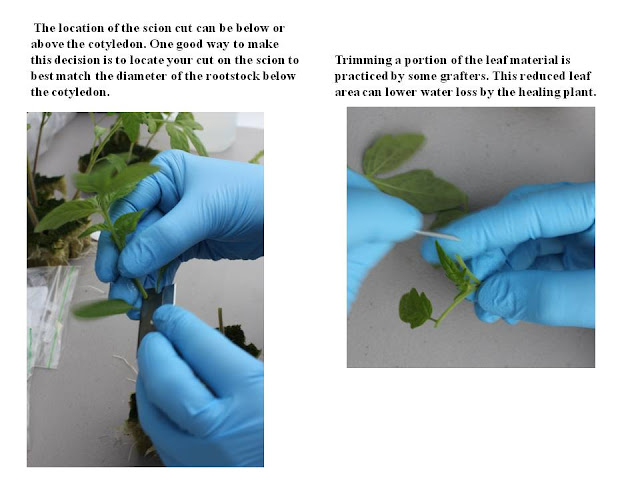An Introduction to the Process of Grafting in Greenhouse Tomatoes- Part 1

|
A row of young grafted and ungrafted tomato plants
being trialed in our research greenhouse in Lodi, OH.
All the grafting was done on site this winter.
|
Grafting sounds interesting, so where should I begin?In the last blog post, we discussed some of the basics of grafting and the main reasons that growers would be interested in the technique. It is no surprise that over the last few decades, the use of grafting has become quite prevalent in greenhouse tomato production. While the benefits are intriguing for small to mid-scale producers, decisions related to acquiring grafted seedlings must be made.The two broad options are to purchase grafted seedlings or to produce all the seedlings needed in your operation on your own. Seedling purchase and transport costs can be quite high in some instances. So, producing grafts for your own operation is a viable option. It also provides the opportunity to trial a limited number of grafted plants or test different cultivars. There is certainly a learning curve for producing grafted plants, though. So, I would suggest starting by only planning to graft a small portion of your crop the first year to become familiar with the process and it potential benefits in your operation.
Overview of the grafting process
There are three crucial steps in the process of grafting your own tomato plants. 1) Setting the Stage, 2) Doing the Grafting, and 3) Healing the Grafts.
1.Setting the Stage-
It is important to remember that grafting will change the space and time needs of your typical seedling production schedule. It will also require some investigation into rootstocks that will best fit with the cultivars you are currently growing (now referred to as scions). Rootstocks, like greenhouse tomato scions, tend towards more vegetative or generative growth patterns, and these attributes will influence how they will perform in your greenhouse operation. It will likely be beneficial to try a few different rootstocks to determine how they impact your crop.
Also, more seed will need to be ordered, and seeding will need to take place earlier to meet typical schedules. It is best to allow an extra week or two in your schedule to account for graft healing. Due to seeding both rootstocks and scions, more space will be needed in the seeding area as well. Prior to beginning seeding for grafting, it is also important to do some seed germination trials as rootstocks and scions may not have the same germination percentage or rate. Growth rate of the seedlings may also differ. Having rootstock and scion plants of similar size is critical for grafting, so multiple seedings are recommended . Remember to keep detailed records of seeding and germination as these will be valuable in planning for future years.
2. Doing the Grafting-
There are several methods of grafting, and benefits and potential drawbacks to each. For further information on some the grafting technique variations, the resources listed at the end of this post provide additional discussions. In current greenhouse tomato propagation, the most widely used method is the tube graft (also known as the splice graft or Japanese top graft). The tube or splice graft is what I have used for grafting in the CropKing research greenhouse. The advantages of the tube graft are the young plant size at which it can be completed and the potential for high throughput in grafting operations. It is a method than can be done quickly by hand, but it is also suitable for mechanized grafting as is more often carried out in Europe.
Before grafting begins, make sure to adequately address sanitation in your operation. Sanitation is very important in the grafting process, and poor practices in this area have caused loss to both propagators and growers in the past. The process starts with using high quality, clean seed ( and therefore plant) materials. Then care should be taken during the process starting with clean work surfaces and utensils. Periodic changes in razor blades and hand washing are also important steps during grafting. So, without further delay, let me give you a brief overview of the main steps and techniques used for tube grafting that would be appropriate to use in your own greenhouse tomato crop.
Where to find additional information
Many Land-Grant Universities are currently carrying out research and publishing information in the area of use and management of grafted tomatoes. While some of the research is tailored to soil-based, outdoor or high tunnel production, there is still much the soilless greenhouse grower can learn from these publications- especially on the topic of grafting and healing methods. Some grafting related materials from universities active in the area include:
Greenhouse tomatoes greenhouses hydroponics hydroponic

